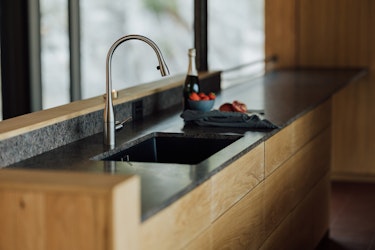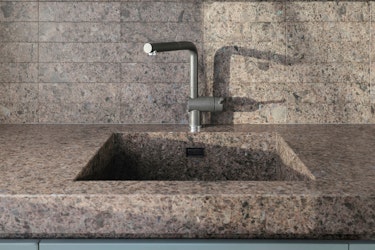
Worktop in Lundhs Antique in silk/leather.
Choosing the right finish
One of the many decisions you have to make is the finish of the worktop. From a more textured surface to a glossier, polished option, there are two main finishes to choose from:
Polished
A polished surface has a glossy and reflective appearance that will enhance the visual appeal of the material. Choosing this finish will create a luxurious and sophisticated look that can elevate the overall aesthetic of any space. With its natural light reflecting abilities, it helps spaces appear brighter and more spacious.
Silk/Leather
A silk/leather finish is more structured and textured. It offers a non-glossy, low-reflective finish, which results in an understated appearance that is often associated with minimalism and contemporary design. In this finish, the stone tends to appear slightly lighter than a polished finish.
Choosing the right thickness
Choosing the right thickness for your worktop will depend on three main factors: the cost, durability and supporting unit. For worktops in general, the variety of sizes, colours and textures usually come in an array of thicknesses.
A slimmer worktop is favoured by those looking for a sleek and contemporary appearance that is in line with modern interior design trends. Less material also means it is more cost-efficient. As a general rule, we would recommend avoiding anything thinner than 20mm.
A thicker worktop is ideal for heavy-duty work surfaces, such as in busy kitchens, and areas that require additional durability - however it is important to ensure your kitchen or bathroom cabinets are able to support the weight when being installed. A thicker surface also creates an eye-catching aesthetic and adds a sense of luxury to a space. If you’re looking to introduce something bold and impactful, a thicker worktop is for you.

Lundhs Antique in silk/leather. The thickness of the worktop is 20mm.
Choosing the right edging
Choosing the right edging is extremely important as it makes a huge difference to the overall look and functionality of the design. From avoiding sharp corners if you have children to adding softness with a curved edge, we’ll talk you through which one might be right for you.
Bevelled
Perhaps the most common is a bevelled edge. Slanting downwards with a curved edge finish, it lacks sharp angles and is generally safer in environments where children may come into contact with them. The bevelled edge also adds depth and sophistication and works well in classic and traditional kitchens.
Bullnose/Half Bullnose
Offering a completely curved edge, it adds softness and fluidity to a kitchen - as well as being the best choice for young families. The shape adds sophisticated comfort and works best in traditional kitchens. If you’re looking to incorporate a rounded edge, but want something that is easy to clean, consider a ‘half bullnose’, which offers a rounded top and flat bottom.
Shark's Nose
The "Shark's Nose" edge profile is a unique design option for kitchen or bathroom worktops. This profile features a smoothly rounded edge that slightly protrudes from the worktop's surface, similar to the shape of a shark's nose. It provides a distinctive and creative aesthetic for worktops. However, it's worth noting that this edge profile is not a standard or widely available option and may require custom fabrication.
We hope our guide has helped you understand the importance of finishing touches when choosing a worktop. To find out more about our collection of natural stone, take a look here.